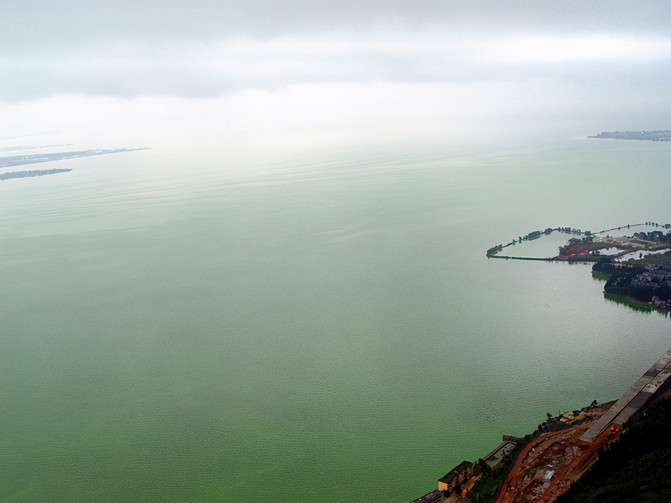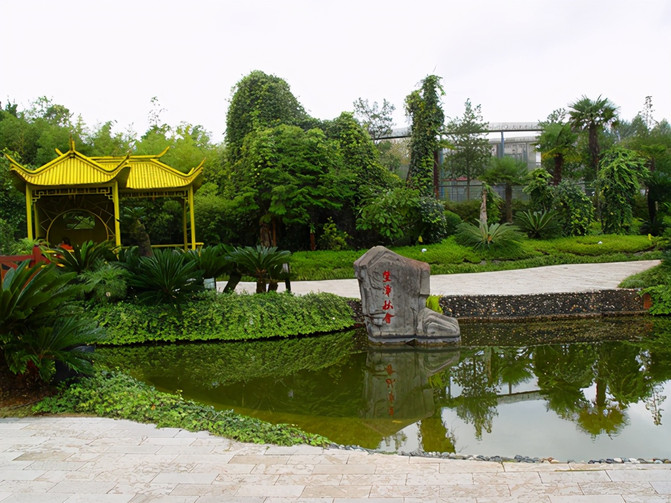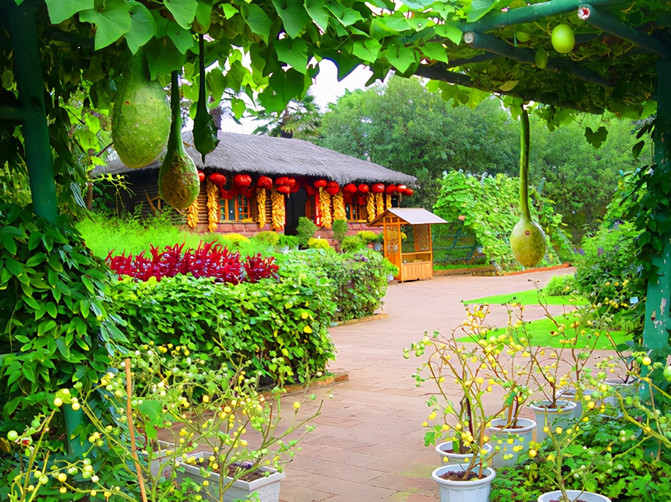Yunnan Tourism: Entering the Spring City of Kunming (Photo)
Kunming, the capital city of Yunnan, which is like spring all year round, was the last stop of the reporter's trip to Yunnan in November 2005 with the China Railway Travel Xiangyungui tourist train. This is also the third time I have visited this beautiful city since April 1994 and December 1998.

Kunming Railway Station (Photo: Feng Ganyong)
At 8:20 a.m. on November 1, 2005, when the China Railway Tourism Train arrived at Kunming Station, tourists were delighted to find that the familiar smiling faces of local tour guides who had just separated four days ago were already waiting on the platform. They warmly welcomed Beijing guests who had returned successfully from Dali and Lijiang to Kunming again.

Xishan Scenic Area (Photo: Feng Ganyong)
Golden Dragon buses loaded with tourists filed out and left Kunming Railway Station. According to the itinerary plan, the tour group will successively visit the Xishan Scenic Area and the Kunming World Horticultural Expo Park in Kunming.

Kunming Garden Expo Park (Photo: Feng Ganyong)
Kunming has a history of more than 2,400 years. It is the center of politics, economy, culture, science and technology, and transportation in Yunnan Province. It is also a famous historical and cultural city and an excellent tourist city in my country.

Xishan Sightseeing Cableway (Photo: Feng Ganyong)
Kunming is located in the middle of the Yunnan-Guizhou Plateau, with an altitude of 1,891 meters in the city center. It is bordered by Dianchi Lake in the south and surrounded by mountains on three sides. It belongs to the low-latitude plateau mountain monsoon climate. Due to the influence of the warm and humid air current in the southwest of the Indian Ocean, the sunshine is long, the frost period is short, and the average annual temperature is 15.C. The climate is mild, with no scorching heat in summer and no severe cold in winter. The seasons are like spring and the climate is pleasant. It is a very famous "Spring City".

The blue waves reflect the moon landscape (Photo: Feng Ganyong)
Every year from December to March, a group of red-billed gulls that escape the cold wind in the northern sea fly from afar and inhabit Kunming. In Kunming Cuihu, the scene of swarming birds is a beautiful scenery unique to Spring City.

The vast Dianchi Lake (Photo: Feng Ganyong)
The total area of Kunming City is about 15560 square kilometers, of which the urban area is about 98 square kilometers. The total population is 4 million. All 26 ethnic groups in the province live in Kunming.

Xishan Yaocheng Pavilion (Photo: Feng Ganyong)
Kunming is also a place where natural landscapes and cultural landscapes gather. Its long history and unique geological structure have left many cultural relics, monuments and scenic spots in Kunming. Kunming is a developing international tourist city. Now it has formed a multi-functional tourist resort centered on the World Expo that integrates natural scenery and ethnic customs and is suitable for all seasons.

Longmen Landscape (Photo: Feng Ganyong)
The tour group first arrived at the Xishan Scenic Area, 15 kilometers away from the center of Kunming City. Xishan Scenic Area is adjacent to the west bank of Dianchi Lake. It is said here that in ancient times, phoenixes stopped, but those who saw them did not recognize them. They called them Biji, hence the name Biji Mountain.

Photo taken by Xishan (Photo: Wang Jue)
The West Mountain starts from Bijiguan in the north and reaches Huiwan in the south. It consists of Biji Mountain, Huating Mountain, Taihua Mountain, Taiping Mountain, Luohan Mountain and other peaks. It rises from north to south, with an altitude of about 2,507.2 meters. The highest Luohan Mountain is higher than the water level of Dianchi Lake. About 620 meters. Because it is shaped like a reclining Buddha, it is also called reclining Buddha Mountain.

Overlooking Kunming City (Photo: Feng Ganyong)
Overlooking Dianchi Lake from the West Mountain is one of the best places to enjoy its beautiful scenery. Dianchi Lake is a plateau limestone fault collapsed lake formed by the influence of the Tertiary Himalayan Movement. It has a sea height of 1886 meters. The lake surface is 39 kilometers long from north to south, 13.5 kilometers wide from east to west, and an average width of about 8 kilometers. The shoreline is about 200 kilometers long; The lake area is 318 square kilometers; the deepest depth of the lake is 8 meters, the average depth is 5 meters, and the water storage capacity is about 1.57 billion cubic meters. Among the many lakes in Yunnan, it has the largest area; among the inland lakes in the country, it ranks sixth.

Grottoes on the cliff (Photo: Feng Ganyong)
The West Mountain has dense forests, lush flowers and plants, is quiet and beautiful, and has excellent scenery. It has been known as "the best place in central Yunnan" in ancient times. Viewed from the southeast of Kunming City, the West Mountain is like a beautiful woman lying on both sides of Dianchi Lake. Her head, chest, abdomen, and legs can be vividly remembered, and her green hair fluttered in the waves and shadows of Dianchi Lake. She looked graceful and charming, so she was also called the Sleeping Beauty.

Longmen Grottoes Plank Road (Photo: Feng Ganyong)
The Longmen Grottoes can be called a famous scenic spot in the West Mountain. It is located at the terminal of the Xishan Scenic Area. It starts from Sanqing Pavilion in the north and ends at Datiange in the south. It is the largest and most exquisite Taoist grotto in Yunnan. "Longmen Scenic Spot" is characterized by "strange, wonderful, dangerous and secluded". It ranks first among the many scenic spots in the West Hills of Kunming and enjoys a high reputation at home and abroad. Most tourists who visit Kunming come here. Therefore, there is a saying that "if you don't play with the Western Hills, you won't be able to visit Kunming, and if you don't reach Longmen, you will only have a wasted trip to the Western Hills."

Xishan Longmen (Photo: Feng Ganyong)
The Longmen Grottoes were excavated from 1781 to 1853 AD and lasted for 72 years. Wu Laiqing, Yang Rulan and Yang Jitai organized many stonemons to dig in three stages. This grotto was completed by hand with one hammer and one chisel along the cliff. It includes stone carvings, platforms, Longmen stone workshops, stone chambers, couplets, statues, ceilings, stone walls, sacred tables, incense burners, candlesticks, offerings, etc. Its structure and layout are beautiful and the carving is exquisite. The Kuixing, Wenchang and Guansheng in the interior are all chiseled from stone rock, which is exquisite.

Looking at Longmen from afar (Photo: Feng Ganyong)
Climbing the Dragon Gate, there is a cylindrical stone square at the entrance with the word "Dragon Gate" written on it and engraved with "Yuan Bao". It is said that it can bless people's prosperity and good luck, so tourists like to touch it with their hands. There is a small semicircular platform protected by stone railings at the entrance. Standing on the platform and looking out, one can see the wind above and the cliff below. The 500-mile Dianchi Lake is vast and the clouds are steaming in the sky. White sails dot on the lake, and orioles fly and swallows dance.

Monument stone of famous places (Photo: Feng Ganyong)
In the distance, green mountains are like white clouds, green trees and white houses, and lush plains are like poetry and picturesque, making people feel like immortals. Turning around and looking back at the stone room, the words "Datiange" are engraved on the top of the main entrance, and the words "Famous Mountain","Stone Room" and "Tianlinhai Mirror" are engraved on the top of the side doors on both sides. The inscription on the middle column is linked to the cloud: If you are difficult to walk, you must stand firm; If you are in the sky, it is more appropriate to calm down.

Xishan Datiange (Photo: Feng Ganyong)
There is a censer carved at the entrance of the stone chamber for worship, and a Kuixing is carved in the center, which is revered by Taoism as the god of writing, also known as Wenqu Star; Emperor Wenchang is carved in the north, who is the god of fame and position; Emperor Guan Shengdi (Guan Yu) is carved in the south, who is the god of martial arts who dominates the suppression of demons. The two walls are engraved with a picture of the galloping god, and the ceiling is engraved with auspicious clouds and cranes flying in pairs.

Inscription of Longmen in Xishan Mountain (Photo: Feng Ganyong)
A flat peach with blue leaves and red fruits is lifelike. The entire project of Longmen is carefully carved on a piece of natural rock. The conception is ingenious and the craftsmanship is superb, which is amazing. But as long as you observe carefully, you will find that the nib on Kuixing's hand is installed separately.

Touch Longmen Yuanbao with your hands (Photo: Feng Ganyong)
Legend has it that there was a master who participated in the stone chamber carving project who had an unfortunate marriage. Later, he participated in the Longmen carving and worked hard with his partners for more than ten years. When he finally carved the red pen in Kuixing's hand, he accidentally chiseled the tip of the pen, making it a perfect piece of art left a flaw. He was so sad that he jumped off the dragon gate. The moving story of his dedication to art will be passed down through the ages together with the grottoes and will be sung by future generations.

Nie Er's Cemetery (Photo: Feng Ganyong)
Tourists first take the cableway to the back door of the Xishan Mountains. After entering the scenic area, they walk up and down the mountain. On one side is the misty Dianchi Lake and on the other is the steep rock wall. After entering the Longmen Scenic Area, you must go down the mountain from a cave that can only pass through for one person. It's not interesting. Walking down the mountain from Longmen to the end, you will arrive at the main entrance of the Xishan Scenic Area.

Statue of musician Nie Er (Photo: Feng Ganyong)
At the gate of the Xishan Scenic Area, the cemetery of people's musician Nie Er is placed here. Nie Er's original tomb was built on stilts in the spring of 1938. It was moved to Xishan in May 1980. In January 1988, it was announced by the State Council as the third batch of national key cultural relics protection units.

Nie Erzhi's Tomb (Photo: Feng Ganyong)
Nie Er's tomb is piano-shaped and solemn. The seven flower stands represent the seven-tone scale, and the 24 stone steps indicate that Nie Er was 24 years old. The conception is ingenious and has profound meaning. In front of the tomb, there is a statue of Nie Er carved out of white marble, and the embossed on the protective wall behind it shows the glorious years when the Chinese people united in the war of resistance inspired by the "March of the Volunteers."

Photo taken at the Horticulture Expo Park (Photo: Liu Jie)
After leaving the Xishan Scenic Area, the tour group heads to the World Horticultural Expo Park, about 4 kilometers away from downtown Kunming. The Kunming World Expo Park covers an area of about 218 hectares, with a vegetation coverage rate of 76.7%. Among them, there are 120 hectares of gentle slopes with dense bushes, and the water surface accounts for 10% to 15%. A total of 9 countries and international organizations have built their own special exhibition parks (stations) here, and many provinces and municipalities in China have also built exhibition venues that can reflect the garden art of the region. It can be said that this is a super-large expo site that brings together horticultural scenery from all over the world.

Wuzhou Style (Photo: Feng Ganyong)
The Expo Park consists of the China Pavilion, the Greenhouse, the Man and Nature Pavilion, the Science and Technology Pavilion, the International Pavilion and the outdoor exhibition area. It condenses a variety of unique Chinese and foreign buildings, reproduces the organic integration of beautiful nature and modern technology, and reflects the horticultural styles and development levels of countries around the world. The Expo Park is not only the grand view garden of the world's gardening and horticulture, but also an ocean of flowers and a world of flowers...

Jiangnan Garden (Photo: Feng Ganyong)
Because the Kunming World Expo Park is so large, it is almost impossible to swim in just over two hours in the afternoon. Therefore, the reporter chose scenic spots such as the China Pavilion, the International Horticultural Exhibition Area, the People and Nature Museum, and the Vegetable and Fruit Garden to visit. But even then, I still feel tight for time.

Taiwan Garden Exhibition Area (Photo: Feng Ganyong)
The China Pavilion has a total construction area of 19927 square meters and an area of 33000 square meters. It is the largest indoor exhibition hall of the '99 World Expo. It, together with the Museum of Man and Nature and the Main Square of the Greenhouse (New Century Square), constitutes the main venue area of the World Expo. The architectural style of the China Pavilion combines Han Dynasty palace buildings and southern residential buildings. Green tiles and white walls. Green represents life and a symbol of gardening. White represents peace and harmony.

Float Parade (Photo: Feng Ganyong)
In the Expo Park, the Chinese Exhibition Park and the International Exhibition Park are places where tourists gather photos, because these two exhibition parks, which are set up outdoors, display more representative and famous landscapes from various places. The domestic exhibition park brings together famous landscapes from all municipalities, provinces, autonomous regions, administrative regions and Taiwan across the country.

International Exhibition Park Sultan (Photo: Feng Ganyong)
The international exhibition area displays representative landscapes of countries around the world. Here, through different regions, distinctive buildings or landscapes from 32 countries including Asia, Europe, Oceania, and America, including the United States, Britain, France, Germany, Russia, Japan, Vietnam, India, Egypt, Israel, and Australia are displayed. Tourists walk into it, as if they feel like going abroad.

Front of the International Pavilion (Photo: Feng Ganyong)
The Museum of Man and Nature is composed of three hexagons based on the triangular shape of the ancient ecological plant clover after regular deformation as the basic unit. The building structure adopts stainless steel grid, which is highly regular and freely divided into space. The roof adopts composite aluminum plates with decorative functions., and the top of the building is 15 meters high. The total construction area is 4953 square meters, the floor area is 19148 square meters, the site pavement area is 1800 square meters, the green area is 6290 square meters, and the landscape pool area is 6100 square meters.

Netherlands in the exhibition garden (Photo: Feng Ganyong)
The colorful varieties in the vegetable and melon garden make tourists dizzying. This theme is "Vegetables, melons and fruits are important food sources for human survival". It mainly shows people China's agricultural development, develops my country's rich and colorful varieties of vegetables, melons and fruits, and advocates wild vegetables and fruits without side effects, chemical fertilizers, and pesticides. Melons and fruits.

America in the exhibition garden (Photo: Feng Ganyong)
The vegetable melon and fruit garden exhibition method mainly adopts outdoor living cultivation. The types on display are: about 85 varieties of vegetables, about 99 varieties of fruit trees, and about 20 varieties of melons. In particular, some huge melons and fruits make tourists amazed.

Vegetable and melon garden (Photo: Feng Ganyong)
The Kunming Expo Park is so large that most tourists cannot visit all the scenic spots. This more or less left a little regret in the entire trip to Kunming. I believe that if people have the opportunity to come to Spring City again, they will definitely come to Kunming World Horticultural Exposition Park to have a good look.

Photo taken of the Kunming event (Photo: Wu Ling)
Time flew by and another 12 years passed. On November 10, 2017, the reporter came to Kunming again for participating in the "2017 China Bicycle League Yunnan Kunming Finals and Kunming Round-Dianchi Plateau Bicycle Invitational Tournament".

galloping along the banks of Dianchi Lake (Photo: Feng Ganyong)
The three-day cycling event around Dianchi Lake allowed reporters to enjoy the beautiful scenery of Dianchi Lake up close, which was much more wonderful than the impression they had on the distant view of Dianchi Lake during the last trip to the Longmen Grottoes in the West Mountain.

Scenery of Dianchi Lake (Photo: Feng Ganyong)
Especially due to the event activities, the reporter rode a wind-collecting motorcycle and rode riders on a beautiful road that was completely enclosed along the Dianchi Lake. The feeling was really pleasant...

Journalists gather wind from the competition (Photo: Zi Qi)
At this time, Dianchi Lake is endless, and the beautiful scenery is displayed in front of you from a distance. As the wind blows in your ears, the competitive passion of the perfect combination of speed and passion has been vividly reflected. (Photo and text: Feng Ganyong)
